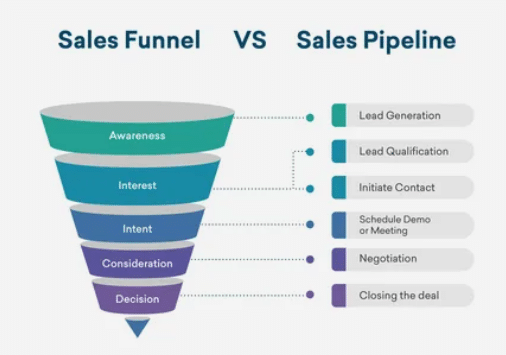In the realm of business, where revenue generation is the ultimate goal, an effective sales pipeline is a vital component for sustained growth and success. But what exactly is a sales pipeline? In this comprehensive guide, we will delve into the intricacies of sales pipelines, exploring their definition, purpose, key stages, and how they can empower businesses to achieve their sales objectives.
Defining a Sales Pipeline
A sales pipeline refers to the systematic and visual representation of the entire sales process, from prospecting to closing deals. It is a strategic framework that allows businesses to track and manage their interactions with potential customers, guiding them through each stage of the buyer’s journey.
A sales pipeline serves as a roadmap for sales teams, providing a clear understanding of where prospects are in the sales process and what actions are required to move them closer to making a purchase. By organizing and visualizing the sales journey, a pipeline enables businesses to optimize their sales efforts, increase efficiency, and maximize revenue generation.
That Must be Done

At its core, a sales pipeline represents a systematic and visual representation of the entire sales process. It serves as a blueprint that outlines the journey from initial contact with a prospect to the final conversion into a paying customer. Essentially, it provides a roadmap for businesses to navigate their way towards achieving revenue targets and fostering sustainable growth.
Within the sales pipeline, each stage represents a significant milestone in the customer acquisition journey. These stages can vary depending on the nature of the business, but commonly include prospecting, qualification, needs analysis, presentation, negotiation, and closing. By organizing the sales process into distinct phases, the pipeline offers a clear understanding of where prospects stand in the conversion process, allowing sales teams to allocate their efforts effectively.
The sales pipeline also serves as a valuable tool for forecasting and tracking sales performance. By assigning a monetary value to each stage, businesses can estimate potential revenue and identify areas where the pipeline may be experiencing bottlenecks or inefficiencies. This visibility enables companies to make informed decisions and implement strategic initiatives to optimize their sales processes.
To effectively manage a sales pipeline, businesses must adopt a proactive approach. This involves consistent monitoring of key performance indicators (KPIs) at each stage. Metrics such as conversion rates, average deal size, and sales cycle length provide valuable insights into the overall health of the pipeline and highlight areas for improvement.
To ensure a smooth flow within the sales pipeline, it is crucial to establish a solid framework for lead generation and nurturing. By capturing and qualifying leads through various marketing channels, businesses can populate their pipeline with high-quality prospects. Implementing lead scoring methodologies, where leads are evaluated based on their likelihood to convert, allows sales teams to prioritize efforts and focus on the most promising opportunities.
Communication and collaboration among team members are paramount in optimizing the sales pipeline. Regular meetings and shared access to relevant data facilitate alignment and ensure that everyone is working towards common goals. Additionally, leveraging technology, such as customer relationship management (CRM) systems, can provide automation and streamline processes, enabling sales professionals to devote more time to building relationships with prospects.
Conclusion
In conclusion, a sales pipeline serves as an indispensable framework for businesses seeking to achieve consistent revenue growth. By providing a visual representation of the sales process, it empowers organizations to make informed decisions, forecast accurately, and drive efficiency throughout the customer acquisition journey. Through strategic management, monitoring of KPIs, and effective lead generation, businesses can propel their sales pipeline towards success, converting prospects into loyal customers and fueling long-term business growth.
Read More:
- Understanding CRM: Unleashing the Power of Customer Relationship Management
- Types of CRM Software: A Comprehensive Overview
- How B2B Sales Teams Win with Digital Commerce: A Strategic Insight
- Demystifying the Digital: What is Digital Marketing?
- Sales Automation Tools: Supercharging Efficiency in the Sales Ecosystem